As an Amazon Associate I earn from qualifying purchases.
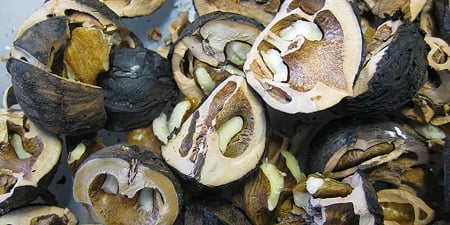
You’d think that if anything would bring out the Greed of Man in me, it would be truffles, a sexy, intoxicating food that can fetch $300 a pound or more. Yet I’ve given plenty of them away to my friends without a second thought.
No, what really makes me feel like Gollum from Lord of the Rings, the wild food I hold most precious, is my store of shelled black walnuts. Don’t even ask. You can’t have any. They are mine I tell you, all mine!
For those of you who don’t know what a black walnut is, it is a generic term for the wild walnuts native to North America. There is one main species east of the Rockies, two in California, and a couple of others in Arizona and Texas. Black walnuts are, more or less, related to hickory nuts and butternuts.
What’s the difference between black walnuts and the kind you get in the store? The vast majority of walnuts you buy in stores are English (also called Persian) walnuts, which are larger and easier to shell than black walnuts. In some places you can buy them in stores, and you can buy black walnuts online.
Size is not the main difference between black walnuts and domesticated ones. Flavor is. Black walnuts taste far stronger than regular ones: More concentrated, walnut-y, and even a touch more bitter.
To me they are the difference between cream and skim milk, grouse and chicken, a wild strawberry and one of those gigantic ones grown on the coast of California. I will take black walnuts over regular ones any time, and for any price.
Luckily that price is free: Black walnut trees grow all around us here in Northern California. My friend Josh tipped me off to a great spot, too, which has so many old trees it took my just 10 minutes to fill two 5-gallon buckets.
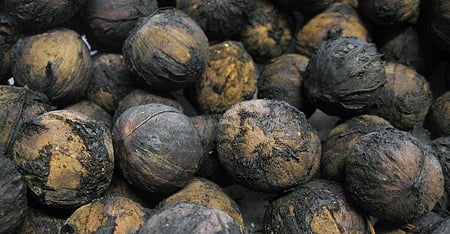
OK, maybe I lied. Black walnuts are not free — if you take time into consideration. Nothing I have ever done, not winemaking, gardening, big-game hunting, processing acorns or curing olives is as labor-intensive as harvesting, hulling and shelling black walnuts. As my fellow forager Connie Green says, “black walnuts are a fortress.” Here’s the method I figured out to storm the gates.
First you need to harvest the walnuts at the correct stage of ripeness.
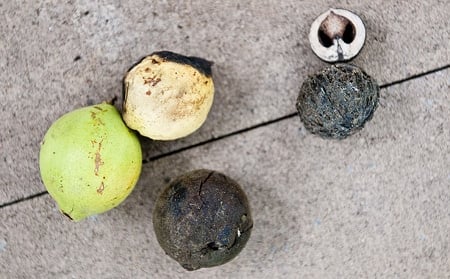
For starters, walnuts will probably not be ripe where you live until October, so wait until then to begin. November should be fine, too, and you can pick up fallen nuts from the ground around the trees into December, but by then our Little Gray Friends the squirrels will have had at them.
So you’re standing at a tree. You see all these forms of walnuts in front of you. Which to pick?
Green ones will most likely still be on the trees. Yes, you can collect them, but they have a surprise in store for you. The beige ones are rotting green ones — they are the hardest to work with, but the nut inside will still be fine. The black one at the bottom is how you will find most of your walnuts: It has its hull rotted and is pretty dry. Finally, if you’ve had lots of rain, you will find some nuts that will be pre-hulled, like the one under the half-shell.
Pick only pre-hulled walnuts that feel heavy for their size, as they will dry out in the shell once hulled.
For the most part, you will need to hull your walnuts. Lots of people say you should just drive over them with a car, but this stains your driveway. Stain? Why yes. Black walnut juice stains like nothing else. And it will not come off with any amount of scrubbing. If you fail to wear gloves when you hull black walnuts, you will have the Black Hand of Death for several days.
Sam Thayer, in his book Nature’s Garden, suggests stomping on the hulls in the field to get them off. This works, but incompletely in my experience with Northern California walnuts, Juglans hindsii. So I sit outside on my porch with three buckets — one with walnuts in it, one for the soon-to-be-hulled walnuts, and one for the hulls. I then don gloves and use a pocketknife to hull the nuts by hand.
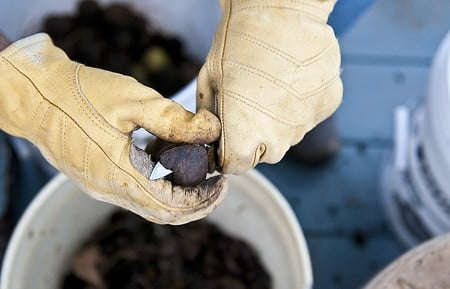
You want a relatively dull knife that you can slice with and not be in danger of it piercing your work gloves. The work can get a little slippery, especially with the green walnuts — remember the surprise? That’s it. A half-hulled green walnut is slipperier than goose shit on a doorknob. This is why I prefer the walnuts with the fully rotted black hulls.

Beware when you are hulling walnuts outdoors. Our Little Gray Friends could be lurking anywhere, just waiting to steal your walnuts for themselves. I use a biological countermeasure to keep the squirrels away:

Once hulled, your work has just begun. Now you must shell your walnuts.
This is the point at which you can kick back a bit. Hulled walnuts store well in the shell, and in fact crack better once they’ve dried for a few weeks.
Once you start shelling, however, you need to banish from your head all notions that you will be able to crack black walnuts and get those pretty perfect halves you can get with regular walnuts. Won’t happen. Bits and pieces are the price of precious black walnut meats.
I crack mine with a hammer, on the concrete floor of my garage. Such force is necessary. I’ve never heard of a regular nutcracker fierce enough to break a black walnut, although some people in the Midwest, where the Eastern species lives, have created special black walnut shellers. Anyone ever use one? I’ll buy one if they work well…
The key to the hammer technique is to use a terrycloth towel to cover the nuts, so the pieces don’t fly all over the room. Use a towel you don’t care about, as it will get holes. Smack the nut with enough force to break it, but not enough to pulverize the nut; after a few, you’ll get the hang of it.
So now you have a bucket of cracked nuts. You’re still not done! Now you need to gently remove the meats from the impossibly complex interior of the walnut. I find the best piece of equipment to do this is a stout pair of wire cutters and a nutpick. I use the wire cutters to clip the shells in key spots so larger pieces of walnut fall out. Again, after a few dozen nuts you’ll begin to know where to clip. The nutpick’s use is obvious. This is tedious work, people. I do it while watching football.
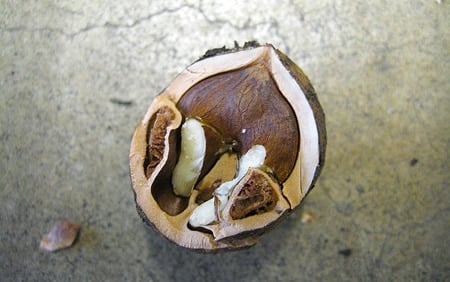
Let me tell you before you begin a black walnut adventure that you need to be patient. It took me probably six hours of work to get 15 ounces of nutmeats — although that includes hulling all of my nuts, not just the portion I cracked and picked. But all this work is worth it.
Just the aroma of black walnuts is payment for the effort: They smell toasted without actually being so. And I’ve already mentioned the flavor, which is so strong many recipes say just half the amount of black walnuts will fully replace the flavor of regular ones. I’m not so sure about that, but you can use a bit less. If you want.
Which brings me, finally, to what I do with my black walnuts. In holiday season, I make a Christmas cookie from my childhood:
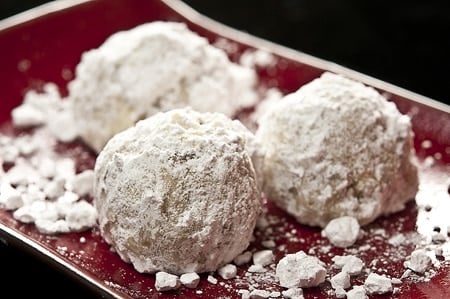
It is my version of a traditional walnut snowball cookie, also known as a Russian teacake or a Mexican wedding cake. My version has black walnuts, of course, but also orange flower water and a little orange liqueur. It’s an awesome cookie, a riff off one my mum has made for decades.
These cookies are stupid easy to make — no mixer necessary, just clean hands — and are so good you really need to make a double batch, because you will eat half of them before your friends or family come home. Trust me on this one.


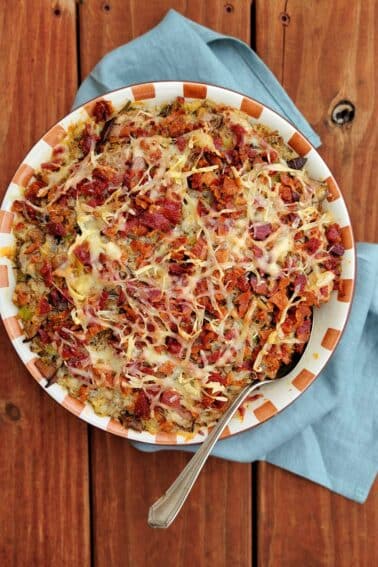


To hull ours, we put the walnuts, a few pounds worth at a time, in a five gallon pail, and filled it with water only so that the walnuts were covered by maybe an inch of water. We then attached a paint stirrer to an electric drill and ran the drill. Works like a charm, though it is extremely messy…(I did ours in the driveway, on a sunny November day, and totally trashed the clothes I had on)
We have two black walnut trees that alternate bearing years. My husband, who grew up on this land had never tried one, but I knew…
In Virginia we have hull maggots that do most of the hulling for you – just wait until they’re brown and the hull will come right off. I hose them down after that because I don’t want to bring the maggots in the house. We crack them with a bench vise while watching movies or telling stories. I put a towel over the shell to keep fragments from flying everywhere, but the living room always requires a sweep afterward.
To simplify picking the meats, we actually let them dry out in the house for an entire year. Some of them don’t make it that long, but we always make sure we’re cracking the oldest ones first. In this way I’ve been able to get nuts out in halves! After the first year, when we got nothing but shelly walnut flour, I find it so satisfying! The nuts still have a strong oily taste. I think no quality is lost.
Using them in chocolate brownies makes you think a liqueur has been used. The difference in flavor is astonishing. Thank you for sharing your technique.
We had a black walnut tree in Kentucky when I was a kid. My father had a good thing going assigning all that dirty work to his kids. Loved the walnuts though. The wire cutter is a good tip.
I found that a multi purpose paint scraper works best for removing the husk. The tool has a half round side of the scraper intended for removing the leftover paint of a paint roller. You just peal the husk right off. I like to drop them in a tub to water to wash off the leftover gook.
My work has about 10 wild walnut trees next to the parking lot. They don’t always give off nuts but when they do there are tons of them. Last year I took about 50 pounds of un-hulled nuts. I hulled them last summer and still have them in the shell in my garage. Would they still be ok if I shelled them this year?
I would spend a few evenings a week, for 3 months shelling black walnuts. I eventually ended up with 2 quarts of walnut meat. I’ve made your snowball cookies and I’m hoping to make your black walnut Ice cream. They are a frustrating amount of work, but mostly worth it. They keep a long time in the refrigerator or freezer.
I tried harvesting this year since the tree was super fruitful. I live in Kentucky and don’t know the particular black walnut tree. I let the outside get pretty dried off – but still were a lot of white worms inside with all that black muck. I peeled all those off and threw the nuts in a bucket of water and hosed down a few times, then used my compost sifter to dry the nuts (and some plastic rectangular plant holders I had around which also have a mesh bottom) for a couple weeks. I tried cracking a few with an 8″ bar clamp.. So far, I not like the taste. They taste like rotten bananas. Will try drying out some more (thx to this long hot fall!) and see if they taste any better. I also tried making a stain from all that black goop and cooked it down in a crock pot outside then strained and diluted with some denatured alcohol. Not too impressive of a stain, and it smells bad (like olives?) but was fun making the stain.
This was a great article and we have just started the black walnut craze. People really don’t understand the beautiful taste of the black walnuts!
What if you find little white worms when hulling?
Neil: They will not be in the nut itself.
A great walnut cracker is grandpas goody getter. Works better than I have ever found. Go to grandpasgoodygetter.com you will be glad you did.
For Roy Marshall Describe your $50 nut cracker that works for black Walnuts.. we have a tree out back producing black walnuts.. I have a lot hulled and drying.. awaiting the suggested 2 weeks time.. I live in VA
Hey! Me and a friend found your post after cracking a black walnut with a regular nutcracker. So we felt like we had to brag about it.
Have a nice day!
I do 2-3 bushel per year. The worms are just living in the husk… do not effect the nuts. I let the hulls turn black and start to dry and they peel out easily. I have a $50 nut cracker that does a great job… much better than a hammer or vice. I’ve probably done 20 bushel with it without a problem.
@ Liz,
I, too, was turned off when the first one I opened this year to start my new adventure had worms inside. I read more than a few sites about harvesting black walnuts, and one said never mind about the worms. They can’t penetrate the nut. I had already thrown it into the woods. But today I hulled 3 grocery plastic bags of black walnuts and only found a few with worms! My guess is not to worry!
We have been making these for a few years now and we’re always careful to keep them hidden from the kids, (children don’t deserve them they’re that good), they deserve chips ahoy! Amazingly enough the best chocolate chip cookies and best brownie s I have ever tasted both had black walnuts in them!
what do i do about the ones that get supreme in the husk? We have 2 big trees out back that have started dropping ( about a month later than normal). Usually by the time i get around to try harvesting maybe2weeks after a decent amount hace dropped there are worms in half of them. It’s very frustrating because i keep thinking they aren’t any good.
I missed the first couple weeks of my walnut harvesting this year, and have just come home to literally hundreds of walnuts on the ground.
I have always harvested the nuts when yellow, but most of the already fallen nuts are black and split. I have picked up and separated into yellow and black. Will the black nuts still be ok use use? I don’t want to waste the effort of hulling them if they will just be spoiled.
Janette: Yep, I use blackened ones often.
I recently discovered a wood lot with hundreds of black walnut trees, some of them massive, thick at the 4′ level and tall as a 4 story building. And I have entrée to pick all the nuts I want with no limit. The owner only has 9 fingers because he forgot to release the nut when he dropped the hammer on one and bashed his thumb into paste.
There is a quick way to open black walnuts once they’ve been hulled without any banging, vices, nutcrackers, sweating or mess. I just take a pair of diagonal wirecutters, cut directly on the seam at either end: the nut will split in half. Then, using the same cutters, clipping each half at the midway of the shell lets the shell get pulled off leaving the nutmeat mostly intact. There’s no mess , no flying shards and it’s easy.
@Hank Shaw: Hank, I’m in Northern California, too. Want to let me in on where I can score some black walnuts?